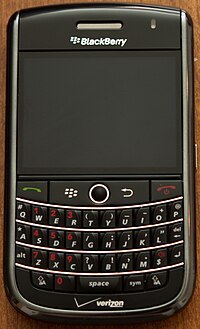 | |
| Manufacturer | Research In Motion |
|---|---|
| Availability by region | July 12, 2009 (Verizon Wireless)[1] July 12, 2009 (Sprint)[2] July 15, 2009 (Telus)[3] July 9, 2009 (Bell Mobility) [4] August 20, 2009 (Alltel) [5] October 27, 2009 (U.S. Cellular) |
| Successor | BlackBerry Bold 9650 |
| Compatible networks | CDMA2000/EV-DO Rev. A 800/1900 MHz UMTS/HSPA: 2100 MHz GSM/GPRS/EDGE: 850/900/1800/1900MHz |
| Form factor | Candybar smartphone |
| Weight | 130 grams, 4.6 ounces |
| Operating system | BlackBerry OS 5.0 |
| CPU | Qualcomm MSM7600 at 528 MHz |
| Memory | 128 MB SDRAM |
| Storage | 256 MB Flash memory |
| Removable storage | 2 GB microSD card included; expandable up to 16 GB |
| Rear camera | 3.2 MP |
| Display | 480×360 half VGA, 2.4" (built on 100μm pixel) |
| Connectivity | Bluetooth 2.0 |
| Data inputs | Trackball, keyboard |
| Development status | Discontinued (2011) |
The BlackBerry Tour is a consumer smartphone developed by BlackBerry Limited (known at the time as Research In Motion) and is part of the 9600 device series.[6][7] This high-end messaging phone combines the multimedia features of the Curve with the global roaming of the 8830 (with the addition of North American GSM / GPRS / EDGE capability), plus a higher-resolution display, 3.2 megapixel auto-focus camera, overseas 3G data and faster EVDO Rev. A data in the United States and Canada. Other key features include voice calling, video capture, a 3.5mm audio jack, a microSD slot, push email, a QWERTY keyboard, Bluetooth, and GPS navigation. The BlackBerry Tour was released on July 12, 2009.[2][8] In 2010, the 'Tour 2' refresh was re-branded as the Blackberry Bold 9650 when RIM decided to merge the GSM and CDMA2000 variants under the same brand.
- ^ "BlackBerry Tour officially hitting Verizon on July 12th". The Boy Genius Report. Jun 29, 2009. Retrieved 1 August 2009.
- ^ a b "Sprint to launch BlackBerry Tour on July 12th, $199.99". The Boy Genius Report. Jul 1, 2009. Retrieved 1 August 2009.
- ^ "TELUS launching the BlackBerry Tour and HTC Snap on July 15th, Touch Pro2 on the 21st". The Boy Genius Report. Jul 5, 2009. Retrieved 1 August 2009.
- ^ "Bell releases BlackBerry Tour 9630 at $249.95!". MobileSyrup.com. July 10, 2009. Retrieved 1 August 2009.
- ^ "Alltel launches the BlackBerry Tour". The Boy Genius Report. August 20, 2009. Retrieved 20 August 2009.
- ^ "Let's Clear Up The BlackBerry Niagara BlackBerry Javelin Confusion". RIMarkable. May 6, 2008. Retrieved 1 August 2009.
- ^ "BlackBerry Niagara 9630 Coming to Verizon in May". Gizmodo. Mar 19, 2009. Retrieved 1 August 2009.
- ^ "Sprint Getting the Blackberry Tour on July 12th". Gizmodo. Jul 1, 2009. Retrieved 1 August 2009.